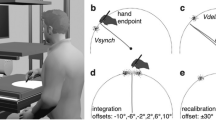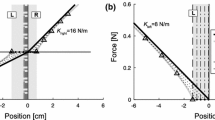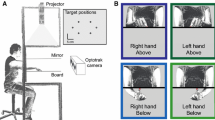Abstract
To enable us to study how humans combine simultaneously present visual and proprioceptive position information, we had subjects perform a matching task. Seated at a table, they placed their left hand under the table concealing it from their gaze. They then had to match the proprioceptively perceived position of the left hand using only proprioceptive, only visual or both proprioceptive and visual information. We analysed the variance of the indicated positions in the various conditions. We compared the results with the predictions of a model in which simultaneously present visual and proprioceptive position information about the same object is integrated in the most effective way. The results are in disagreement with the model: the variance of the condition with both visual and proprioceptive information is smaller than expected from the variances of the other conditions. This means that the available information was integrated in a highly effective way. Furthermore, the results suggest that additional information was used. This information might have been visual information about body parts other than the fingertip or it might have been visual information about the environment.
Similar content being viewed by others
References
Beers RJ van, Sittig AC, Denier van der Gon JJ (1995) The effectiveness of the integration of visual and proprioceptive information in man (abstract). Eur J Neurosci [Suppl]8:196
Crowe A, Keessen W, Kuus WAW, Van Vliet REC (1985) Non-visual assessment of finger-tip positions in a horizontal plane (abstract). J Physiol (Lond) 366:94P
Crowe A, Keessen W, Kuus W, Van Vliet R, Zegeling A (1987) Proprioceptive accuracy in two dimensions. Percept Mot Skills 64:831–846
Fisher RA (1966) The design of experiments, 8th edn. Oliver and Boyd, London
Fisher RA (1970) Statistical methods for research workers. Oliver and Boyd, London
Gandevia SC, Burke D (1992) Does the nervous system depend on kinesthetic information to control natural limb movements? Behav Brain Sci 15:614–632
Gordon J, Ghilardi MF, Ghez C (1994) Accuracy of planar reaching movements. I. Independence of direction and extent variability. Exp Brain Res 99:97–111
Graaf JB de, Sittig AC, Denier van der Gon JJ (1994) Misdirections in slow, goal-directed arm movements are not primarily visually based. Exp Brain Res 99:464–472
Gregory RL (1959) Eye movements and the stability of the visual world. Nature 182:1214–1216
Hamilton CR (1964) Intermanual transfer of adaptation to prisms. Am J Psychol 77:457–462
Helms Tillery SI, Flanders M, Soechting JF (1991) A coordinate system for the synthesis of visual and kinesthetic information. J Neurosci 11:770–778
Helms Tillery SI, Flanders M, Soechting JF (1994) Errors in kinesthetic transformations for hand apposition. Neuroreport 6:177–181
Howard IP (1982) Human visual orientation. Wiley, New York
Jeannerod M (1988) The neural and behavioural organization of goal-directed movements. Clarendon, Oxford
Jeannerod M (1991) The interaction of visual and proprioceptive cues in controlling reaching movements. In: Humphrey DR, Freund HJ (ed) Motor control: concepts and issues. Wiley, New York
Jeka JJ, Lackner JR (1994) Fingertip contact influences human postural control. Exp Brain Res 100:495–502
Jordan S (1970) Ocular pursuit movement as a function of visual and proprioceptive stimuli. Vis Res 10:775–780
Lackner JR, DiZio P (1994) Rapid adaptation to Coriolis force perturbations of arm trajectory. J Neurophysiol 72:299–313
Matthews PBC (1988) Proprioceptors and their contribution to somatosensory mapping: complex messages require complex processing. Can J Physiol Pharmacol 66:430–438
Paillard J, Brouchon M (1968) Active and passive movements in the calibration of position sense. In: Freedman SJ (ed) The neuropsychology of spatially oriented behavior. Dorsey, Illinois, pp 37–55
Paillard J, Brouchon M (1974) A proprioceptive contribution to the spatial encoding of position cues for ballistic movements. Brain Res 71:273–284
Prablanc C, Jeannerod M, Tzavaras A (1975a) Independent and interdependent processes in prism adaptation. In: Vital-Durand F, Jeannerod M (ed) Aspects of neural plasticity. INSERM, Paris, pp 139–152
Prablanc C, Tzavaras A, Jeannerod M (1975b) Adaptation of the two arms to opposite prism displacements. Q J Exp Psychol 27:667–671
Prablanc C, Echallier JF, Komilis E, Jeannerod M (1979) Optimal response of eye and hand motor systems in pointing at a visual target. I. Spatio-temporal characteristics of eye and hand movements and their relationships when varying the amount of visual information. Biol Cybern 35:113–124
Rossetti Y, Meckler C, Prablanc C (1994) Is there an optimal arm posture? Deterioration of finger localization precision and comfort sensation in extreme arm-joint postures. Exp Brain Res 99:131–136
Rossetti Y, Desmurget M, Prablanc C (1995) Vectorial coding of movement: vision, proprioception, or both? J Neurophysiol 74:457–463
Scott SH, Loeb GE (1994) The computation of position sense from spindles in mono- and multiarticular muscles. J Neurosci 14:7529–7540
Sittig AC, Denier van der Gon JJ, Gielen CCAM (1985) Separate control of arm position and velocity demonstrated by vibration of muscle tendon in man. Exp Brain Res 60:445–453
Slinger RT, Horsley V (1906) Upon the orientation of points in space by the muscular, arthrodial, and tactile senses of the upper limbs in normal individuals and in blind persons. Brain 29:1–27
Soechting JF, Flanders M (1989) Sensorimotor representations for pointing to targets in three-dimensional space. J Neurophysiol 62:582–594
Taylor JR (1982) Introduction to error analysis. Oxford University Press, Oxford
Wann JP, Ibrahim SF (1992) Does limb proprioception drift? Exp Brain Res 91:162–166
Author information
Authors and Affiliations
Rights and permissions
About this article
Cite this article
van Beers, R.J., Sittig, A.C. & van der Gon Denier, J.J. How humans combine simultaneous proprioceptive and visual position information. Exp Brain Res 111, 253–261 (1996). https://doi.org/10.1007/BF00227302
Received:
Accepted:
Issue Date:
DOI: https://doi.org/10.1007/BF00227302




